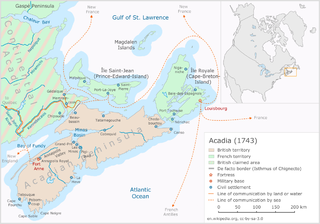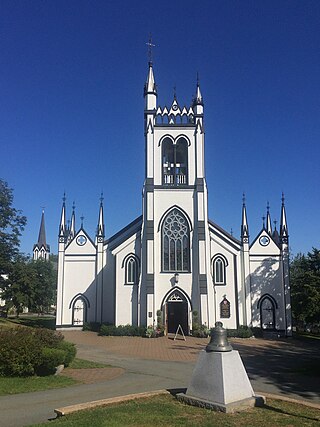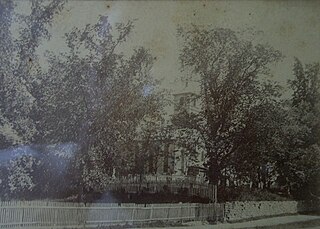
The Presbyterian Church in Canada is a Presbyterian denomination, serving in Canada under this name since 1875. The United Church of Canada claimed the right to the name from 1925 to 1939. According to the Canada 2001 Census 409,830 Canadians identify themselves as Presbyterian, that is, 1.4 percent of the population.

Edward Cornwallis was a British career military officer and was a member of the aristocratic Cornwallis family, who reached the rank of Lieutenant General. After Cornwallis fought in Scotland, putting down the Jacobite rebellion of 1745, he was appointed Groom of the Chamber for King George II. He was then made Governor of Nova Scotia (1749–1752), one of the colonies in North America, and assigned to establish the new town of Halifax, Nova Scotia. Later Cornwallis returned to London, where he was elected as MP for Westminster and married the niece of Robert Walpole, Great Britain's first Prime Minister. Cornwallis was next appointed as Governor of Gibraltar.

St. Paul's Church is an evangelical Anglican church in downtown Halifax, Nova Scotia, within the Diocese of Nova Scotia and Prince Edward Island of the Anglican Church of Canada. It is located at the south end of the Grand Parade, an open square in downtown Halifax with Halifax City Hall at the northern end.

The Old Burying Ground is a historic cemetery in Halifax, Nova Scotia, Canada. It is located at the intersection of Barrington Street and Spring Garden Road in Downtown Halifax.

Jonathan Binney was a merchant, judge and political figure in Nova Scotia. He was a member of the 1st to 3rd Nova Scotia House of Assemblies from 1758 to 1765. He arrived in Nova Scotia in 1753. His father-in-law was Henry Newton. Binney was buried, along with his two sons Stephen and Hibbert, in the Old Burying Ground in Halifax, Nova Scotia.

John Creighton was one of the founding fathers of Lunenburg, Nova Scotia. He led the settlement through the turbulent times of Father Le Loutre's War, the French and Indian War and the American Revolution. He represented Lunenburg County in the Nova Scotia House of Assembly from 1770 to 1775. After establishing the town, he lived the rest of his life in the village until he died fifty-four years later.

Father Le Loutre's War (1749–1755), also known as the Indian War, the Mi'kmaq War and the Anglo-Mi'kmaq War, took place between King George's War and the French and Indian War in Acadia and Nova Scotia. On one side of the conflict, the British and New England colonists were led by British officer Charles Lawrence and New England Ranger John Gorham. On the other side, Father Jean-Louis Le Loutre led the Mi'kmaq and the Acadia militia in guerrilla warfare against settlers and British forces. At the outbreak of the war there were an estimated 2500 Mi'kmaq and 12,000 Acadians in the region.

The Foreign Protestants were a group of non-British Protestant immigrants to Nova Scotia, primarily originating from France and Germany. They largely settled in Halifax at Gottingen Street and Dutch Village Road as well as Lunenburg.

Formally known as "His Majesty's Council of Nova Scotia", the Nova Scotia Council (1720–1838) was the original British administrative, legislative and judicial body in Nova Scotia. The Nova Scotia Council was also known as the Annapolis Council and the Halifax Council. After 1749, when the judicial courts were established, the Nova Scotia Council was limited to administrative and legislative powers.

Andrew Brown was Professor of Rhetoric at Edinburgh University and Moderator of the General Assembly of the Church of Scotland in 1813. He was also a historian and author, closely connected to the history of Nova Scotia, having served as a minister at St. Matthew's United Church (Halifax).

Reverend Archibald Gray was an influential Presbyterian minister in Halifax, Nova Scotia. He served in the St. Matthew's United Church (Halifax) for 30 years (1795–1826). Gray was a native of Morayshire and a graduate of King's College, Aberdeen. While he baptized his son at St Matthew's, his mother belonged to the Church of England, and after Gray's death his son entered the Anglican ministry. He was a strong advocate for public education.

St. John's Anglican Church was the first church established in Lunenburg, Nova Scotia, Canada (1753). It is the second Church of England built in Nova Scotia, and is the second oldest continuous Protestant church in present-day Canada. Early on 1 November 2001, St. John's church suffered significant damage by fire. It was restored and re-dedicated June 12, 2005.

Jean-Baptiste Moreau was first minister at St. John's Anglican Church (Lunenburg) (1753-1770) and one of the founding fathers of the community. He was one of two missionaries who first arrived in Halifax with Edward Cornwallis (1749) and served at St. Paul's Church (Halifax). His wife had the first child born in Halifax and was named Cornwallis after the Governor. Then in 1753 he was sent to help establish Lunenburg, Nova Scotia. Rev Moreau served the community throughout the French and Indian War. He reported to Society for Propagation of the Gospel (SPG) in London, "…the number massacred by Indians in Lunenburg District during the War was 32." He learned the Mi'kmaw language and is reported to have baptised a number of Mi'kmaq children. He is buried in the crypt of St. John's Anglican Church

St. Andrew's Presbyterian Church is a church in Lunenburg, Nova Scotia. The congregation is the longest history of any Presbyterian congregation in Canada. After meeting at a private house, the congregation worshipped in St. John's Anglican Church (Lunenburg) (1759-1770). The first church was built in 1770 and the first minister was Reverend Bruin Romkes Comingo, who served the community for 50 years until he died at age 95 (1820). The current church was built in the neo-gothic style and dates from 1828.

Hibbert Newton Binney (1766–1842) was a soldier in the Royal Nova Scotia Volunteer Regiment in the American Revolution. He became a member of the Nova Scotia Council. He was also a painter who created some of the earliest images of the Mi'kmaq people. He was the grandson of Henry Newton and the son of Jonathan Binney who was a signatory to one of the Halifax Treaties with the Mi'kmaq. Hibbert is buried in the Old Burying Ground. There is a mural tablet at St. Paul's Church (Halifax) to his son commander Lieut. John Binney and 11 crew of the mail packet brig Star, that all died at sea. His grandfathers were Henry Newton (politician) and Bishop Hibbert Binney. He was also the son-in-law of John Creighton (judge).

Bruin Romkes Comingo was the first Presbyterian minister ordained in Canada. He arrived in Halifax as a Foreign Protestants during Governor Edward Cornwallis' tenure. He was ordained by Rev. John Seccombe. He served at St. Andrew's Presbyterian Church (Lunenburg), Nova Scotia.

The Old Parish Burying Ground is the oldest protestant cemetery in Windsor, Nova Scotia and one of the oldest in Canada. The graveyard was located adjacent to the first protestant church in Windsor (1788). The oldest marker of Rachel Kelley is dated 1771, twelve years after the New England Planters began to settle the area.

John Payzant was a Foreign Protestant, prominent New Light Congregational minister in Liverpool, Nova Scotia and was taken captive for four years with his siblings and pregnant mother after the Raid on Lunenburg (1756). He was born Jean Paysant in St. Helier, Jersey, Channel Islands to French Huguenots Louis Payzant (1695–1756) and his wife Marie Anne Noget (1711–1796). The family moved to Lunenburg, Nova Scotia, in 1753. At the May 1756 raid, mercenary natives for the French shot and scalped his father and three others. For the first year, he and his siblings were adopted by the Indigenous family while his pregnant mother was taken to Quebec. John learned to speak their native language. He later wrote: “I was [later] a languattor [translator] for the Indians as I had learnt that Language when prisoner among them." After one year of captivity by the natives, he and his siblings were eventually released to re-connect with their mother in Quebec. “When I arrived at Quebec I was sent to the Jesuits to be instructed in the Learning of that Academy and during my stay there I made great proficiency in the Arts that were taught in that School, and as they were fond to proselyte they took the more pains with me." In 1760 they all returned to Nova Scotia, settling in Falmouth. He then became a minister in Liverpool, Nova Scotia (1793). He was part of the Great Awakening and was a follower of Henry Alline and married his sister Mary in 1774. They had one daughter and eight sons. Rev. John Payzant died at 84 and is buried in Liverpool's Old Burying Ground.

Rev. John Seccombe was an author, a founder of Chester, Nova Scotia and was “the best-known and most highly respected clergyman in Nova Scotia.” He was also the author of Father Abbey's Will, which was printed as a poem and a broadsheet over 30 times throughout the 18th century in England and America. According to the Manual of American Literature, the poem "was one of the best comic poems of that day." As a result of the poem, the History of American Literature indicated that Seccombe "had an extraordinary notoriety" in America's early literary history.

























